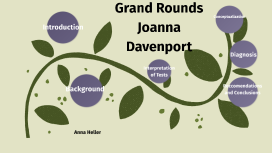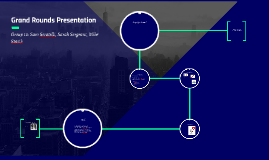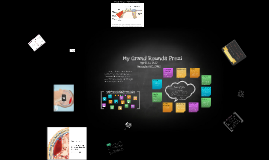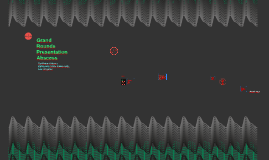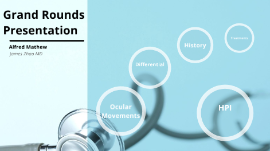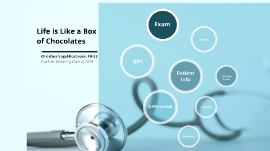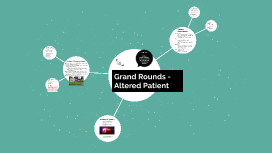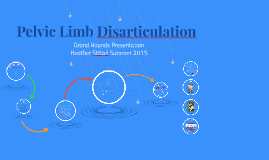Grand Rounds Presentation
Transcript: Clarkson University Class of 2019 Christina Vogel-Rosbrook, PA-S2 Life Is Like a Box of Chocolates Patient Info 69 y/o CM presents to ER CC: "constipated for three days" Differential Differential Diagnosis Appendicitis Abdominal Hernia Diverticulitis Crohn Disease Ulcerative Colitis Perforation Ileus Irritable Bowel Syndrome Large Bowel Obstruction Spontaneous Bacterial Peritonitis Toxic Megacolon Volvulus Ogilvie Syndrome Multiple Sclerosis Lupus Scleroderma Amyloidosis Spinal Cord Injury Parkinson Disease Neuropathy Hypothyroidism Colon Cancer Medication-Induced Hypercalcemia Anal Fissure Fecal Impaction Renal Insufficiency Achalasia Portal Hypertension Cholelithiasis Cholecystitis Celiac Disease Liver Cirrhosis Alcoholic Fatty Liver Disease Non-Alcoholic Fatty Liver Disease Hyperparathyroidism Uremia HPI HPI: Pt reported to ER after 3 days of constipation. Insidious onset of abdominal distention beginning last fall worsened over the past 3-4 days. Associated symptoms include SOB, decreased appetite, severe abdominal distention, and weight fluctuation. He reported first time occurrence. Sxs worsened with time; nothing improved sxs. Medications Medications Neurontin (Gabapentin) - 300 mg PO TID Lipitor (Atorvastatin Calcium) - 40 mg PO daily Synthroid (Levothyroxine) - 175 mcg PO daily Flomax (Tamsulosin) - 0.4 mg PO daily Medical marijuana - for PTSD Intolerance/ Allergies Simvastatin - Headache Pollen Allergy - Congestion. PMH & PSH Past Medical History Frozen Shoulder - Hypertension Hyperlipidemia Type 2 Diabetes Mellitus Post Traumatic Stress Disorder Past Surgical History FH & SH Family History Father 50's y/o. Helicopter accident. Mother 60's. Alcoholism. Brother HTN. Sister Unknown. Sister Alive and well. Sister Alive and well. Daughter 37 y/o. Alive and well. Daughter 34 y/o. Alive and well. Daughter 32 y/o. Alive and well. Daughter 28y/o. Alive and well. Denies family history of liver cancer, cirrhosis, hepatitis, pancreatic cancer, crohn's disease, ulcerative colitis, congestive heart failure. Vietnam Veteran and Retired plumber. Married. Lives with wife, two wolves. Former tobacco and alcohol use. Stopped smoking and drinking about 10 years ago. Registered NYS medicinal marijuana. Denies cocaine or heroin use. Diet: Regular. Exercise: Active with projects around house. Leisure: Enjoys cooking, fixing motorcycles, spending time with family. Safety: Drives with seatbelt. Social History Review of Systems ROS General: +poor appetite, fatigue. No fever, chills. Skin: No open wounds, rashes, lesions, ecchymosis. Head: No headache, trauma, pain. Eyes: No vision changes, blurred vision, photophobia. Ears: No hearing changes, vertigo, tinnitus. Nose: No rhinorrhea, changes in smell, epistaxis. Throat: No dysphagia, sore throat, hoarseness. Neck: No nuchal rigidity, stiffness, lumps. Cardiovascular: No palpitations, chest pain, chest wall pain, orthopnea. Pulmonary: +Dyspnea. No cough, hemoptysis, pleuritic chest pain. Gastrointestinal: +Abdominal distention, diffuse abdominal pain, constipation, early satiety, passing flatus. No nausea, vomiting, diarrhea, hematochezia, melena. Genitourinary: +Rentention. No dysuria, hematuria, frequency, incontinence. Musculoskeletal: +Left leg pain. No arthralgia, muscle atrophy, myalgia. Neuro: No weakness, numbness, confusion, change in speech. Vascular: +Mild leg edema bilaterally. No increased vascularity, claudication. Endocrine: No heat/ cold intolerance, diaphoresis, polyuria, polydipsia. Psychiatric: No feeling of depression, anxiety, memory loss, harmful thoughts. ROS Physical Exam Exam Vital Signs Blood Pressure - 135/67 Pulse - 72 Temperature - 97.7 degrees Farenheit Respirations - 18 Oxygen Saturation - 96% Room Air Vital Signs Physical Exam Physical Exam General: Skin: Head: Eyes: Ears: Nose: Throat: Neck: Pulmonary: Cardio: Abdomen: Extremities: Msculoskeletal: Neuro: Endocrine: Psych: Tests Labs CBC, CMP, other chemistries Blood Cultures Urinalysis Coagulation Serology Labs CBC, CMP CBC, CMP 13.2 16.2 38.7 285 129 4.6 94 4 113 0.6 29 MCV - 83.2 MCH - 28.4 MCHC - 34.1 RDW - 13.7 MPV - 8.4 Neutorphil% - 84 Lymph% - 7.7 Mono% - 6.8 Eos% - 0.6 Baso% - 0.3 Lactic Acid - 1.0 Calcium Adj for Alb - 11.7 Mag - 1.70 Total Bili - 0.5 AST - 31 ALT - 25 Alk Phos - 89 LDH - 164 Total PRO - 6.8 Albumin - 3.8 Lipase - 57 C-Reactive Protein - 9.11 Other CHEM Other CHEM Lipase - 57 TSH - 24.700 T4 - 10.8 TBG Color - Yellow Clarity - Clear pH - 8.0 Specific Gravity - 1.028 Ketones - Negative Blood - Negative Nitrite - Negative Bilirubin - Negative Urobilinogen - 1.0 Leukocyte Esterase - Negative Total PRO - Negative Urinalysis UA Serology Serology Imaging Imaging EKG EKG Chest X-Ray No Acute Disease. Abdominal CT with contrast "Large 10 cm liver lesion with subhepatic space extension into the small bowel mesentery with changes of perotineal carcinomatosis identified with omental caking and studding as well as ascites. I am concerned about primary cholangiocarcinoma of the






